What Do Speculators Know from High Options Volume? (Part Three)
By Dr. Duru written for One-Twenty
August 27, 2009
Search past articles here.
This is the third in a series of analyses I have run to understand whether high options volume provides any trading information for speculators. The first analysis covered the seven weeks of a distinct market downtrend leading into the expiration of February options (December 20, 2008 to February 20, 2009), and the second analysis covered the seven weeks leading into the March options expiration (January 30, 2009 to March 18, 2009) which included the first two weeks of the bounce from the downtrend. I concluded both times that the overall trend in the market was a more important guide for directional trades than the type of options (calls or puts) experiencing the large trading volume. In other words, a trader should typically initiate a trade in the direction of the prevailing market trend upon observing any high options trading volume. A trader needs to apply additional information (for example, technical analysis) to decide to trade contrary to the existing trend (if any).
I ran two more analyses for seven weeks leading into the April and May expiration (February 27 to April 17, 2009 and March 27 to May 13, 2009, respectively). Both periods covered substantial uptrends, and I came to the same earlier conclusions.
Here is a summary of my conclusions for each analysis...
First analysis using options expiring February 20, 2009:
- The overall (downward) trend in the market dominates stocks' price performance regardless of the options trading. For example, stocks perform nearly the same (mostly negative) between the date of the high options volume and options expiration whether the high options trading volume is only in calls or only in puts. Also, the maximum price gain in a stock improves slightly if just puts are traded in high-volume instead of just calls.
- When both puts and calls are traded in high-volume on the same underlying stock, the stock's price performance is at least equal to the cases where only calls or only puts are traded in high-volume.
Second analysis using options expiring March 20, 2009:
- Stocks in aggregate perform nearly the same between the date of the high options volume and options expiration whether the high options trading volume is only in calls or only in puts. The small performance gaps that exist were even smaller than the first analysis. The strong rally in the last two weeks of this data sample significantly increased the percentage of stocks with maximum gains over 10%, and it notably decreased the percentage of stocks with losses of at least 10%.
- As I found in the first analysis, when both puts and calls are traded in high-volume on the same underlying stock, the stock's price performance is at least equal to the cases where only calls or only puts are traded in high-volume. However, this second analysis seemed to provide even stronger evidence that this kind of trading is the most reliable signal for generating high returns.
- It also still makes sense to close out these trading positions in advance of expiration once you achieve a "significant" move in your favor.
New analysis using options expiring April 17, 2009:
- From the day of the high options trading to expiration, the percentage of underlying stocks achieving maximum gains of 10% or more was nearly identical whether the options traded were calls, puts, or both. The overall distribution of maximum gains was also nearly identical. The overall distribution of maximum losses (minimum gains) was also nearly equivalent.
- Given the prevailing uptrend, options expiration was much more favorable to underlying stocks than in the previous two analyses. The distribution of gains at expiration was only slightly lower than the distribution of maximum gains (no matter how options were traded). The distribution of losses was substantially better than the distribution of maximum losses with no more than 3% of all stocks experiencing at least a 10% loss by expiration.
- Underlying stocks achieved the highest maximum gains when both calls and puts traded in heavy volume. Maximum gains were notably smallest when only calls traded in high volume. All maximum gains distributions were strong due to the prevailing uptrend.
- There was no significant difference in the distribution of minimum gains. All distributions were low with no more than 21% of the underlying stocks experiencing maximum loss of at least 10%.
- Options expiration in May was just as friendly to underlying stocks with heavily traded options as options expiration in April.
- Interestingly, high-volume trading in just calls was the LEAST reliable method for making money on bullish bets. High-volume trading in puts, and even more so trading in calls AND puts, provided a higher likelihood of gains.
For those who want more details on what I did for this latest analysis, read on...
First, I provide the details for my methodology and its limitations in the first analysis. In the second analysis, I dropped the last two days of trading in the series and repeated this step for the last two analyses. I have also finally uncovered a great explanation for the heavy call activity I often observe around the time a stock goes ex-dividend. Quick traders sell deep in-the-money calls against long stock and collect the dividend on any stock that is not called away by an options exercise. Unsuspecting buyers of these calls essentially provide the trading profits. This activity slightly skews my results for calls and makes it even more desirable to focus on large changes in open interest instead of trading volume. The one drawback of a strategy based on changes in open interest is that a trader may miss a fast-developing opportunity or pay a much higher price to participate.
While I missed the options trades on certain days, I was able to record 640 high options trades for the April analysis, the highest of all four. This surge in activity is likely directly related to the surge from the March lows. The trades for the May analyses dropped down to 406. Compare this to 542 for the first analysis and 413 for the second.
My method of comparison is admittedly informal. I greatly simplified the analysis by constructing histograms of the price changes of the underlying stock and by focusing on the percentage of high-volume options trades that preceded at least 10% gain (or loss) in the stock. This time around, I also tried some analysis of variance (ANOVA) to demonstrate the statistical significance of these results. However, the distributions of the price changes are too skewed away from normal to generate meaningful results (I did not try some of the methods for dealing with non-normal distributions).
Read the histograms as plots of price performance for the stock underlying a particular option that has experienced high trading volume. There are three scenarios of options action: 1) calls only, 2) puts only, or 3) calls and puts traded in high volume on a given day. For each scenario, I measure three types of price performance in the underlying stock from the day of the options action to the day of expiration: 1) maximum price change (typically a gain), 2) minimum price change (typically a loss), and 3) price change on the day of options expiration. Price change is measured on closing prices. Each chart represents one type of performance for one scenario. I provide the histogram for the detail and describe the aggregated performance above/below the 10% threshold (reduces the number of total charts to a minimum). The y-axis describes the frequency of occurence for a given price change. The x-axis describes the range of the price changes that I recorded. The value of the left side of the range is "exclusive" to the range (open paranthesis), and the value on the right side of the range is "inclusive" to the range (square paranthesis). Finally, take careful note that the analyses from April AND May are provided below, one after the other.
Here are the charts:
CHARTS FOR APRIL EXPIRATION
Price change from the day of high-volume options activity to the day of maximum stock price before option expiration
62% of the time (153 out of 246 observations), buying stock after observing high-volume trading in calls generated a maximum return over 10% before options expiration (these are all the bars from left to right starting with the one with a frequency of 30%)...
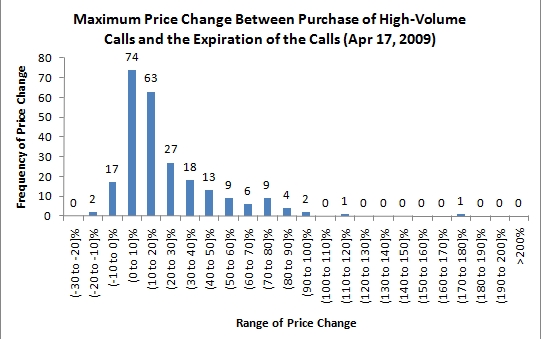
However, 70% of the time (85 out of 121 observations), buying stock after observing high-volume trading in PUTS generated a maximum return over 10% before options expiration!
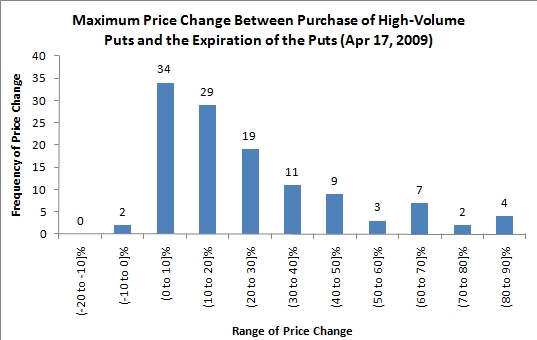
Moreover, 73% of the time (199 out of 273 observations), buying stock after observing high-volume trading in puts AND calls generated a maximum return over 10% before options expiration. Overall, for maximum return, it only matters that a trader observes any high volume in the options trading.
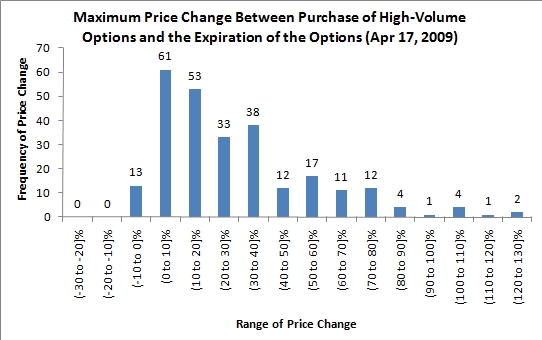
Price change from the day of high-volume options activity to minimum stock price before option expiration
17% of the time, buying stock after observing high-volume trading in calls generated a minimum return (maximum loss) of at least -10%.
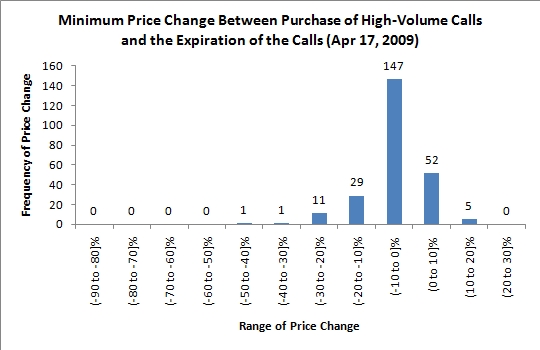
Similarly, 20% of the time, shorting stock after observing high-volume trading in puts generated a maximum gain (listed below as minimum return) of at least 10%.
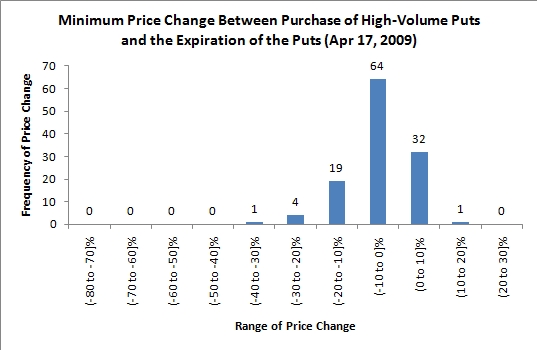
Finally, 21% of the time, buying stock after observing high-volume trading in calls and puts generated a minimum return (maximum loss) of at least 10%. For minimum return (maximum return from going short), it again only matters that options trade in high volume and not whether they are calls and/or puts. However, for April expiration, the prevailing market trend was up, so making any bearish bets provided poor risk/reward and poor returns as a result. Most importantly, the appearance of high volume trading in puts was a very poor differentiating signal for negative price changes.
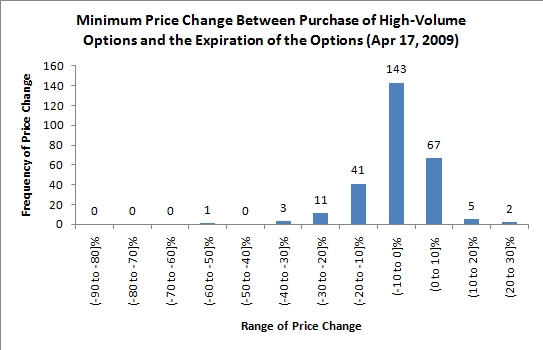
Price change from the day of high-volume options activity to option expiration
Only 2% of the time, buying stock after observing high-volume trading in calls generated a minimum return (maximum loss) of at least -10% at options expiration. 56% of the time buying stock after observing high-volume trading in calls generated a maximum return over 10% at options expiration. This is the kind of performance we might expect in a bullish environment.
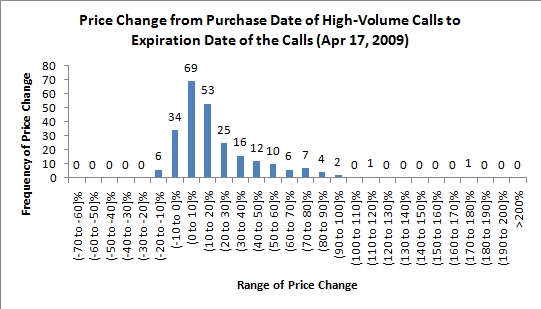
Similarly, 3% of the time, shorting stock after observing high-volume trading in puts generated a maximum gain (listed below as minimum return) of at least 10% at options expiration. 62% of the time, BUYING stock after observing high-volume trading in puts generated a maximum gain of at least 10% at options expiration. As with the above results, there is little difference in performance between call and put trading activity.
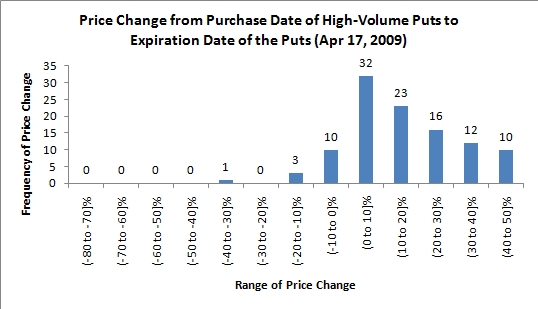
Finally, 3% of the time, buying stock after observing high-volume trading in calls and puts generated a minimum return (maximum loss) of at least 10% at options expiration. 68% of the time buying stock after observing high-volume trading in calls and puts generated a maximum return over 10% at options expiration.
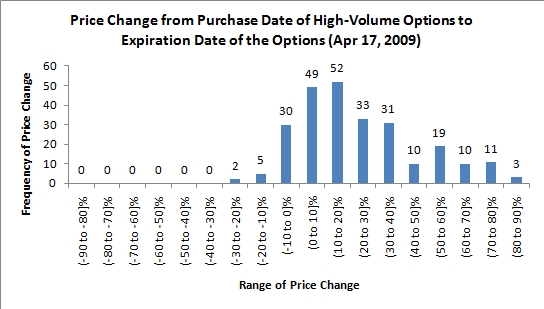
CHARTS FOR MAY EXPIRATION
Price change from the day of high-volume options activity to the day of maximum stock price before option expiration
45% of the time (157 out of 348 observations), buying stock after observing high-volume trading in calls generated a maximum return over 10% before options expiration. This performance is notably worse than the performance from April expiration. Note that the S&P 500 "stalled" out between these expirations for a meager 1.6% gain.

However, 59% of the time (127 out of 216 observations), buying stock after observing high-volume trading in PUTS generated a maximum return over 10% before options expiration. In other words, buying stock after observing high-volume put activity was a more reliable way to make money than following calls!
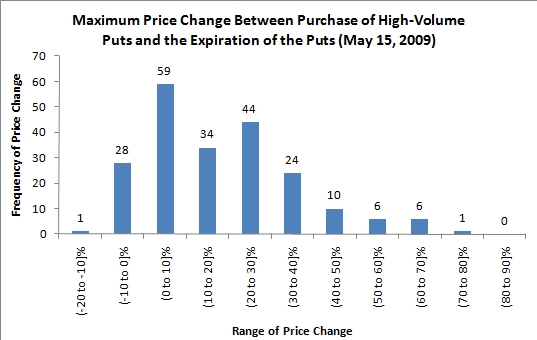
Even more surprising, 68% of the time (356 out of 525 observations), buying stock after observing high-volume trading in puts AND calls generated a maximum return over 10% before options expiration. Overall, for maximum return, it only matters that a trader observes any high volume in the options trading.

Price change from the day of high-volume options activity to minimum stock price before option expiration
26% of the time, buying stock after observing high-volume trading in calls generated a minimum return (maximum loss) of at least -10%.
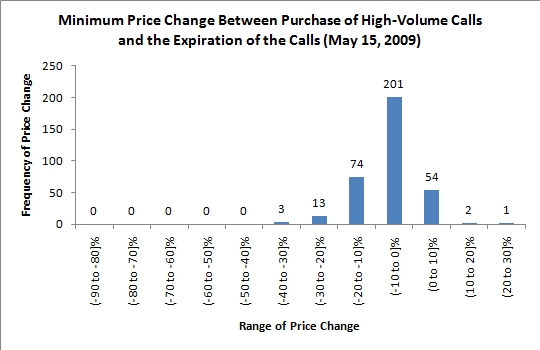
Similarly, 25% of the time, shorting stock after observing high-volume trading in puts generated a maximum gain (listed below as minimum return) of at least 10%.
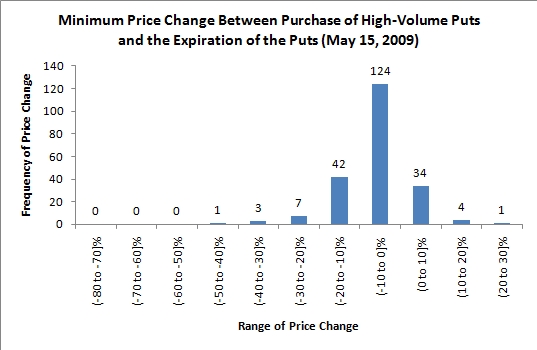
Finally, 23% of the time, buying stock after observing high-volume trading in calls and puts generated a minimum return (maximum loss) of at least 10%. For minimum return (maximum return from going short), it again only matters that options trade in high volume and not whether they are calls and/or puts. However, for May expiration, the prevailing market trend was up, so making any bearish bets provided poor risk/reward and as a result poor returns. Most importantly, the appearance of high volume trading in puts was a very poor signal for negative price changes.

Price change from the day of high-volume options activity to option expiration
Only 19% of the time, buying stock after observing high-volume trading in calls generated a minimum return (maximum loss) of at least -10% at options expiration. 14% of the time buying stock after observing high-volume trading in calls generated a maximum return over 10% at options expiration. This performance was substantially worse than the performance observed for the April expiration.
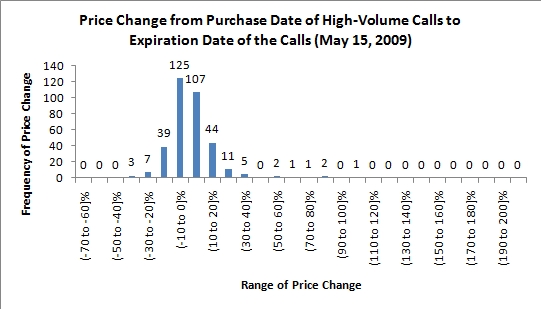
Similarly, 15% of the time, shorting stock after observing high-volume trading in puts generated a maximum gain (listed below as minimum return) of at least 10% at options expiration. 25% of the time, BUYING stock after observing high-volume trading in puts generated a maximum gain of at least 10% at options expiration. While puts were a slightly more reliable indicator of bearish price action than calls were for bullish action by expiration, this overall performance is again substantially worse than that observed for April expiration.
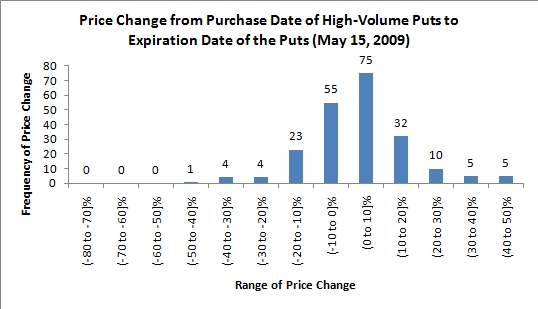
Finally, 15% of the time, buying stock after observing high-volume trading in calls and puts generated a minimum return (maximum loss) of at least 10% at options expiration. 29% of the time buying stock after observing high-volume trading in calls and puts generated a maximum return over 10% at options expiration.
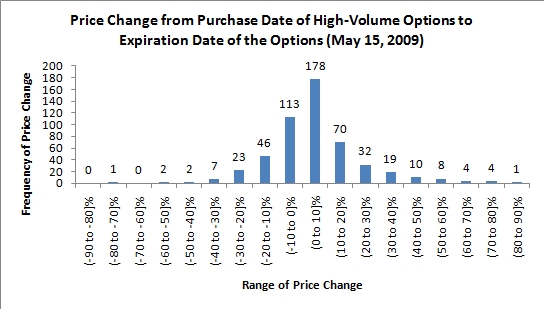
Be careful out there!
Full disclosure: short SSO. For other disclaimers click here.